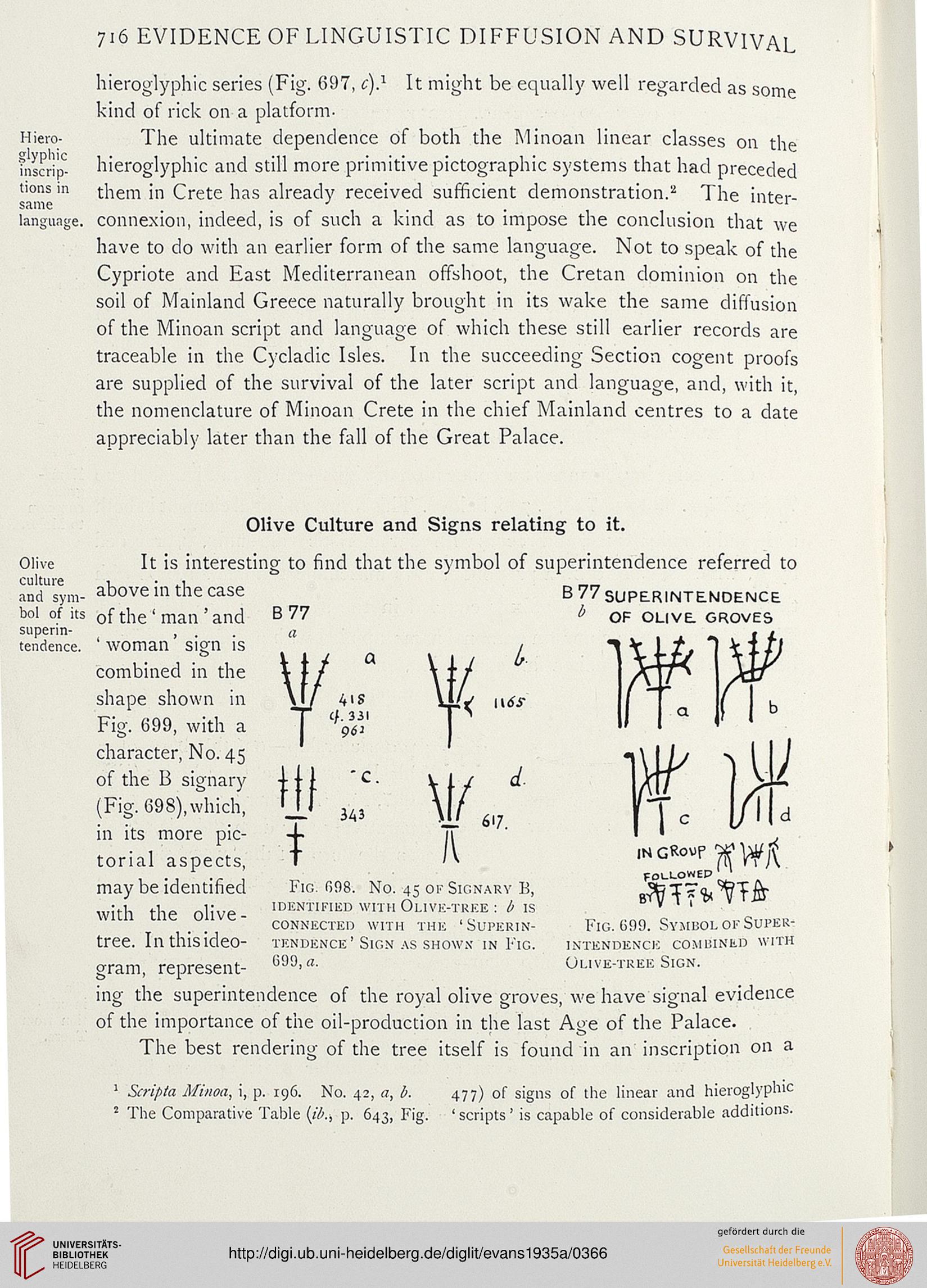Miero-
glyphic
inscrip-
tions in
same
language
716 EVIDENCE OF LINGUISTIC DIFFUSION AND SURVIVAL
hieroglyphic series (Fig. 697, c).1 It might be equally well regarded as some
kind of rick on a platform-
The ultimate dependence of both the Minoan linear classes on the
hieroglyphic and still more primitive pictographic systems that had preceded
them in Crete has already received sufficient demonstration.2 The inter-
connexion, indeed, is of such a kind as to impose the conclusion that we
have to do with an earlier form of the same language. Not to speak of the
Cypriote and East Mediterranean offshoot, the Cretan dominion on the
soil of Mainland Greece naturally brought in its wake the same diffusion
of the Minoan script and language of which these still earlier records are
traceable in the Cycladic Isles. In the succeeding Section cogent proofs
are supplied of the survival of the later script and language, and, with it,
the nomenclature of Minoan Crete in the chief Mainland centres to a date
appreciably later than the fall of the Great Palace.
Olive
and sym- above in the case
bol of its 0f the ' man ' and
supenn- , ,
tendence. ' woman Sign IS
combined in the
Olive Culture and Signs relating to it.
It is interesting to find that the symbol of superintendence referred to
B77
B77
tr.
SUPERINTENDENCE
OF OLIVE GROVES
l
ii.' 61?.
Fig. 098. No. 45 or Signarv E,
IDENTIFIED WITH OlIVE-TREE : li IS
CONNECTED WITH THE 'SUPERIN-
TENDENCE' Sign as shown in Fig.
699, a.
shape shown in
Fig. 699, with a
character, No. 45
of the B signary
(Fig. 698),which,
in its more pic-
torial aspects,
may be identified
with the olive -
tree. In this ideo-
gram, represent-
ing the superintendence of the royal olive groves, we have signal evidence
of the importance of the oil-production in the last Age of the Palace.
The best rendering of the tree itself is found in an inscription on a
in GRovf JP )$fc
followep '
Fig. 699. Symbol of Super-
intendence COMBINED WITH
Olive-tree Sign.
Scripta Minoa, i, p. 196. No. 42, a, b.
The Comparative Table {il>.; p. 643, Fie
477) of signs of the linear and hieroglyph":
'scripts' is capable of considerable additions.
glyphic
inscrip-
tions in
same
language
716 EVIDENCE OF LINGUISTIC DIFFUSION AND SURVIVAL
hieroglyphic series (Fig. 697, c).1 It might be equally well regarded as some
kind of rick on a platform-
The ultimate dependence of both the Minoan linear classes on the
hieroglyphic and still more primitive pictographic systems that had preceded
them in Crete has already received sufficient demonstration.2 The inter-
connexion, indeed, is of such a kind as to impose the conclusion that we
have to do with an earlier form of the same language. Not to speak of the
Cypriote and East Mediterranean offshoot, the Cretan dominion on the
soil of Mainland Greece naturally brought in its wake the same diffusion
of the Minoan script and language of which these still earlier records are
traceable in the Cycladic Isles. In the succeeding Section cogent proofs
are supplied of the survival of the later script and language, and, with it,
the nomenclature of Minoan Crete in the chief Mainland centres to a date
appreciably later than the fall of the Great Palace.
Olive
and sym- above in the case
bol of its 0f the ' man ' and
supenn- , ,
tendence. ' woman Sign IS
combined in the
Olive Culture and Signs relating to it.
It is interesting to find that the symbol of superintendence referred to
B77
B77
tr.
SUPERINTENDENCE
OF OLIVE GROVES
l
ii.' 61?.
Fig. 098. No. 45 or Signarv E,
IDENTIFIED WITH OlIVE-TREE : li IS
CONNECTED WITH THE 'SUPERIN-
TENDENCE' Sign as shown in Fig.
699, a.
shape shown in
Fig. 699, with a
character, No. 45
of the B signary
(Fig. 698),which,
in its more pic-
torial aspects,
may be identified
with the olive -
tree. In this ideo-
gram, represent-
ing the superintendence of the royal olive groves, we have signal evidence
of the importance of the oil-production in the last Age of the Palace.
The best rendering of the tree itself is found in an inscription on a
in GRovf JP )$fc
followep '
Fig. 699. Symbol of Super-
intendence COMBINED WITH
Olive-tree Sign.
Scripta Minoa, i, p. 196. No. 42, a, b.
The Comparative Table {il>.; p. 643, Fie
477) of signs of the linear and hieroglyph":
'scripts' is capable of considerable additions.





